Biomedical Science: MHC Class II and Vitamin D Method Analysis
VerifiedAdded on 2023/01/19
|7
|1794
|60
Practical Assignment
AI Summary
This assignment details a biomedical science experiment investigating the effects of Vitamin D on Human Acute Myeloid Leukemia Cells (KG-1). The study focuses on cell culturing techniques, including the use of Iscoves Modified Dulbecco's Medium and aseptic procedures. The methods section describes the preparation of Vitamin D and Retinoic acid solutions, sample incubation, and the subsequent staining of cells for flow cytometry analysis. Specifically, the assignment outlines the staining procedures for CD38 and HLA-DR surface antigens to quantify protein expression changes, providing insights into cell maturation and activation. The experimental setup includes triplicate cultures, varying treatment conditions (Vitamin D, Retinoic acid, DMSO, and combinations), and the use of a haemocytometer for cell counting. The assignment emphasizes the importance of flow cytometry in analyzing cellular processes and the role of specific molecules like CD38 and HLA-DR in immune cell function and response to treatments.
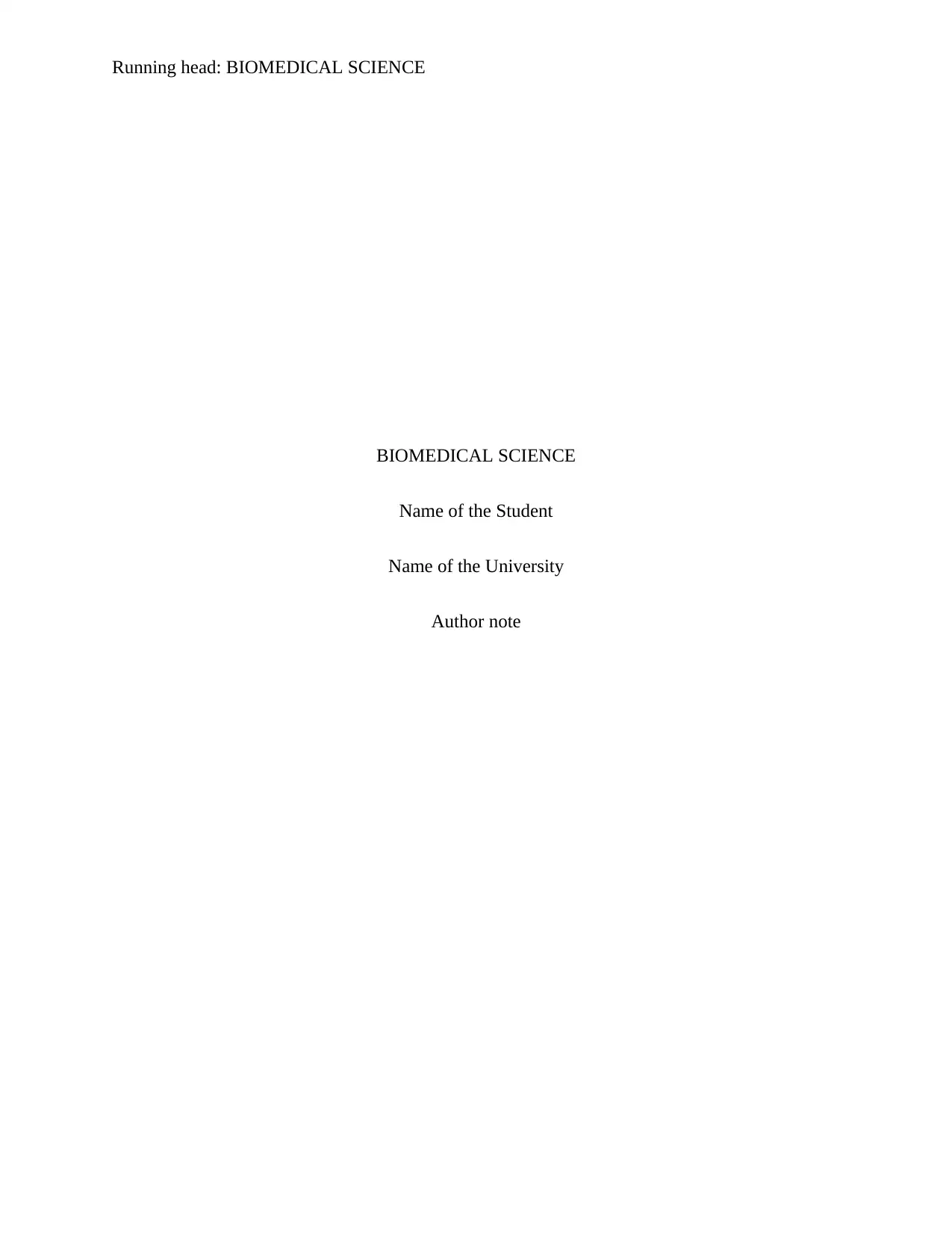
Running head: BIOMEDICAL SCIENCE
BIOMEDICAL SCIENCE
Name of the Student
Name of the University
Author note
BIOMEDICAL SCIENCE
Name of the Student
Name of the University
Author note
Paraphrase This Document
Need a fresh take? Get an instant paraphrase of this document with our AI Paraphraser
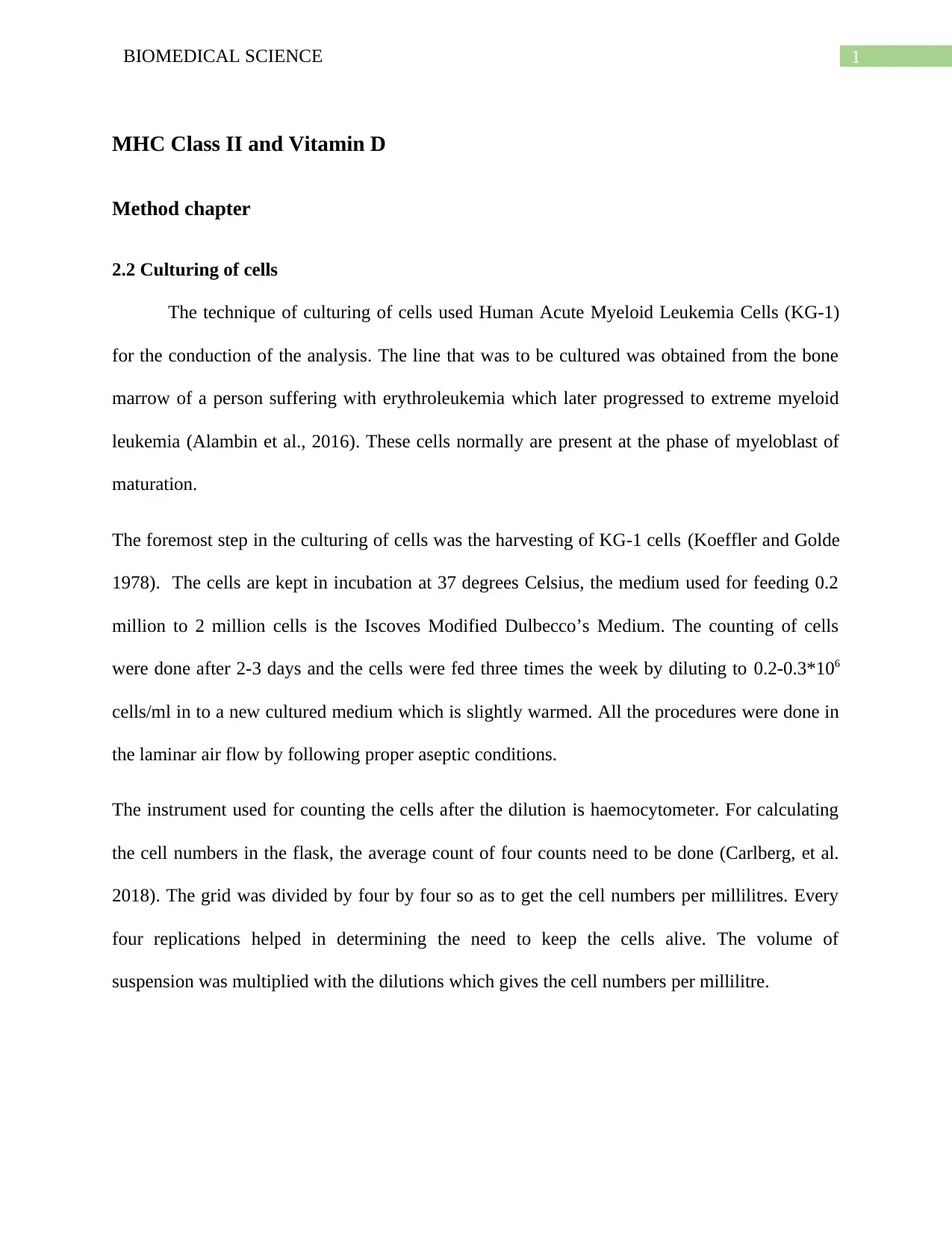
1BIOMEDICAL SCIENCE
MHC Class II and Vitamin D
Method chapter
2.2 Culturing of cells
The technique of culturing of cells used Human Acute Myeloid Leukemia Cells (KG-1)
for the conduction of the analysis. The line that was to be cultured was obtained from the bone
marrow of a person suffering with erythroleukemia which later progressed to extreme myeloid
leukemia (Alambin et al., 2016). These cells normally are present at the phase of myeloblast of
maturation.
The foremost step in the culturing of cells was the harvesting of KG-1 cells (Koeffler and Golde
1978). The cells are kept in incubation at 37 degrees Celsius, the medium used for feeding 0.2
million to 2 million cells is the Iscoves Modified Dulbecco’s Medium. The counting of cells
were done after 2-3 days and the cells were fed three times the week by diluting to 0.2-0.3*106
cells/ml in to a new cultured medium which is slightly warmed. All the procedures were done in
the laminar air flow by following proper aseptic conditions.
The instrument used for counting the cells after the dilution is haemocytometer. For calculating
the cell numbers in the flask, the average count of four counts need to be done (Carlberg, et al.
2018). The grid was divided by four by four so as to get the cell numbers per millilitres. Every
four replications helped in determining the need to keep the cells alive. The volume of
suspension was multiplied with the dilutions which gives the cell numbers per millilitre.
MHC Class II and Vitamin D
Method chapter
2.2 Culturing of cells
The technique of culturing of cells used Human Acute Myeloid Leukemia Cells (KG-1)
for the conduction of the analysis. The line that was to be cultured was obtained from the bone
marrow of a person suffering with erythroleukemia which later progressed to extreme myeloid
leukemia (Alambin et al., 2016). These cells normally are present at the phase of myeloblast of
maturation.
The foremost step in the culturing of cells was the harvesting of KG-1 cells (Koeffler and Golde
1978). The cells are kept in incubation at 37 degrees Celsius, the medium used for feeding 0.2
million to 2 million cells is the Iscoves Modified Dulbecco’s Medium. The counting of cells
were done after 2-3 days and the cells were fed three times the week by diluting to 0.2-0.3*106
cells/ml in to a new cultured medium which is slightly warmed. All the procedures were done in
the laminar air flow by following proper aseptic conditions.
The instrument used for counting the cells after the dilution is haemocytometer. For calculating
the cell numbers in the flask, the average count of four counts need to be done (Carlberg, et al.
2018). The grid was divided by four by four so as to get the cell numbers per millilitres. Every
four replications helped in determining the need to keep the cells alive. The volume of
suspension was multiplied with the dilutions which gives the cell numbers per millilitre.
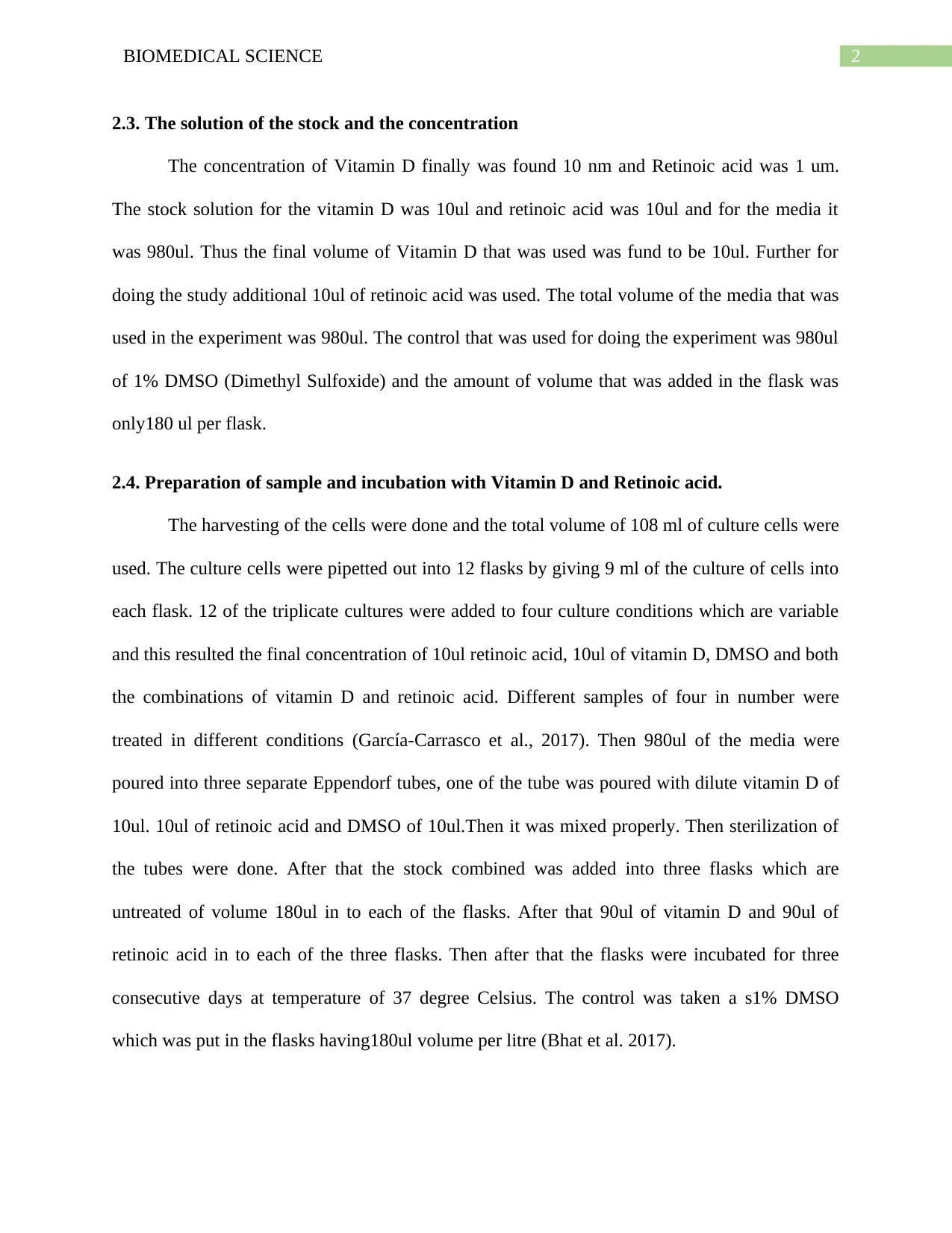
2BIOMEDICAL SCIENCE
2.3. The solution of the stock and the concentration
The concentration of Vitamin D finally was found 10 nm and Retinoic acid was 1 um.
The stock solution for the vitamin D was 10ul and retinoic acid was 10ul and for the media it
was 980ul. Thus the final volume of Vitamin D that was used was fund to be 10ul. Further for
doing the study additional 10ul of retinoic acid was used. The total volume of the media that was
used in the experiment was 980ul. The control that was used for doing the experiment was 980ul
of 1% DMSO (Dimethyl Sulfoxide) and the amount of volume that was added in the flask was
only180 ul per flask.
2.4. Preparation of sample and incubation with Vitamin D and Retinoic acid.
The harvesting of the cells were done and the total volume of 108 ml of culture cells were
used. The culture cells were pipetted out into 12 flasks by giving 9 ml of the culture of cells into
each flask. 12 of the triplicate cultures were added to four culture conditions which are variable
and this resulted the final concentration of 10ul retinoic acid, 10ul of vitamin D, DMSO and both
the combinations of vitamin D and retinoic acid. Different samples of four in number were
treated in different conditions (García-Carrasco et al., 2017). Then 980ul of the media were
poured into three separate Eppendorf tubes, one of the tube was poured with dilute vitamin D of
10ul. 10ul of retinoic acid and DMSO of 10ul.Then it was mixed properly. Then sterilization of
the tubes were done. After that the stock combined was added into three flasks which are
untreated of volume 180ul in to each of the flasks. After that 90ul of vitamin D and 90ul of
retinoic acid in to each of the three flasks. Then after that the flasks were incubated for three
consecutive days at temperature of 37 degree Celsius. The control was taken a s1% DMSO
which was put in the flasks having180ul volume per litre (Bhat et al. 2017).
2.3. The solution of the stock and the concentration
The concentration of Vitamin D finally was found 10 nm and Retinoic acid was 1 um.
The stock solution for the vitamin D was 10ul and retinoic acid was 10ul and for the media it
was 980ul. Thus the final volume of Vitamin D that was used was fund to be 10ul. Further for
doing the study additional 10ul of retinoic acid was used. The total volume of the media that was
used in the experiment was 980ul. The control that was used for doing the experiment was 980ul
of 1% DMSO (Dimethyl Sulfoxide) and the amount of volume that was added in the flask was
only180 ul per flask.
2.4. Preparation of sample and incubation with Vitamin D and Retinoic acid.
The harvesting of the cells were done and the total volume of 108 ml of culture cells were
used. The culture cells were pipetted out into 12 flasks by giving 9 ml of the culture of cells into
each flask. 12 of the triplicate cultures were added to four culture conditions which are variable
and this resulted the final concentration of 10ul retinoic acid, 10ul of vitamin D, DMSO and both
the combinations of vitamin D and retinoic acid. Different samples of four in number were
treated in different conditions (García-Carrasco et al., 2017). Then 980ul of the media were
poured into three separate Eppendorf tubes, one of the tube was poured with dilute vitamin D of
10ul. 10ul of retinoic acid and DMSO of 10ul.Then it was mixed properly. Then sterilization of
the tubes were done. After that the stock combined was added into three flasks which are
untreated of volume 180ul in to each of the flasks. After that 90ul of vitamin D and 90ul of
retinoic acid in to each of the three flasks. Then after that the flasks were incubated for three
consecutive days at temperature of 37 degree Celsius. The control was taken a s1% DMSO
which was put in the flasks having180ul volume per litre (Bhat et al. 2017).
⊘ This is a preview!⊘
Do you want full access?
Subscribe today to unlock all pages.

Trusted by 1+ million students worldwide
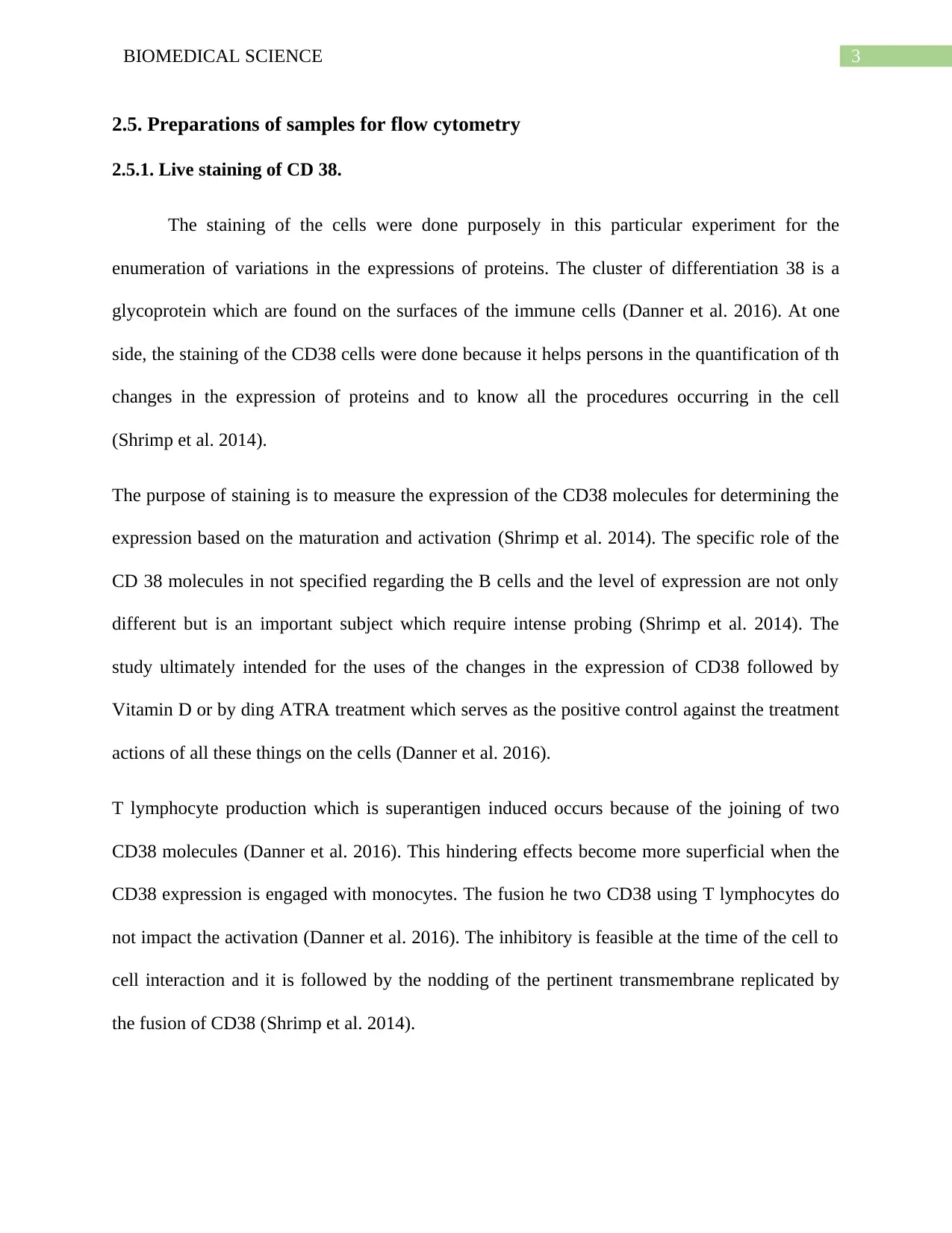
3BIOMEDICAL SCIENCE
2.5. Preparations of samples for flow cytometry
2.5.1. Live staining of CD 38.
The staining of the cells were done purposely in this particular experiment for the
enumeration of variations in the expressions of proteins. The cluster of differentiation 38 is a
glycoprotein which are found on the surfaces of the immune cells (Danner et al. 2016). At one
side, the staining of the CD38 cells were done because it helps persons in the quantification of th
changes in the expression of proteins and to know all the procedures occurring in the cell
(Shrimp et al. 2014).
The purpose of staining is to measure the expression of the CD38 molecules for determining the
expression based on the maturation and activation (Shrimp et al. 2014). The specific role of the
CD 38 molecules in not specified regarding the B cells and the level of expression are not only
different but is an important subject which require intense probing (Shrimp et al. 2014). The
study ultimately intended for the uses of the changes in the expression of CD38 followed by
Vitamin D or by ding ATRA treatment which serves as the positive control against the treatment
actions of all these things on the cells (Danner et al. 2016).
T lymphocyte production which is superantigen induced occurs because of the joining of two
CD38 molecules (Danner et al. 2016). This hindering effects become more superficial when the
CD38 expression is engaged with monocytes. The fusion he two CD38 using T lymphocytes do
not impact the activation (Danner et al. 2016). The inhibitory is feasible at the time of the cell to
cell interaction and it is followed by the nodding of the pertinent transmembrane replicated by
the fusion of CD38 (Shrimp et al. 2014).
2.5. Preparations of samples for flow cytometry
2.5.1. Live staining of CD 38.
The staining of the cells were done purposely in this particular experiment for the
enumeration of variations in the expressions of proteins. The cluster of differentiation 38 is a
glycoprotein which are found on the surfaces of the immune cells (Danner et al. 2016). At one
side, the staining of the CD38 cells were done because it helps persons in the quantification of th
changes in the expression of proteins and to know all the procedures occurring in the cell
(Shrimp et al. 2014).
The purpose of staining is to measure the expression of the CD38 molecules for determining the
expression based on the maturation and activation (Shrimp et al. 2014). The specific role of the
CD 38 molecules in not specified regarding the B cells and the level of expression are not only
different but is an important subject which require intense probing (Shrimp et al. 2014). The
study ultimately intended for the uses of the changes in the expression of CD38 followed by
Vitamin D or by ding ATRA treatment which serves as the positive control against the treatment
actions of all these things on the cells (Danner et al. 2016).
T lymphocyte production which is superantigen induced occurs because of the joining of two
CD38 molecules (Danner et al. 2016). This hindering effects become more superficial when the
CD38 expression is engaged with monocytes. The fusion he two CD38 using T lymphocytes do
not impact the activation (Danner et al. 2016). The inhibitory is feasible at the time of the cell to
cell interaction and it is followed by the nodding of the pertinent transmembrane replicated by
the fusion of CD38 (Shrimp et al. 2014).
Paraphrase This Document
Need a fresh take? Get an instant paraphrase of this document with our AI Paraphraser
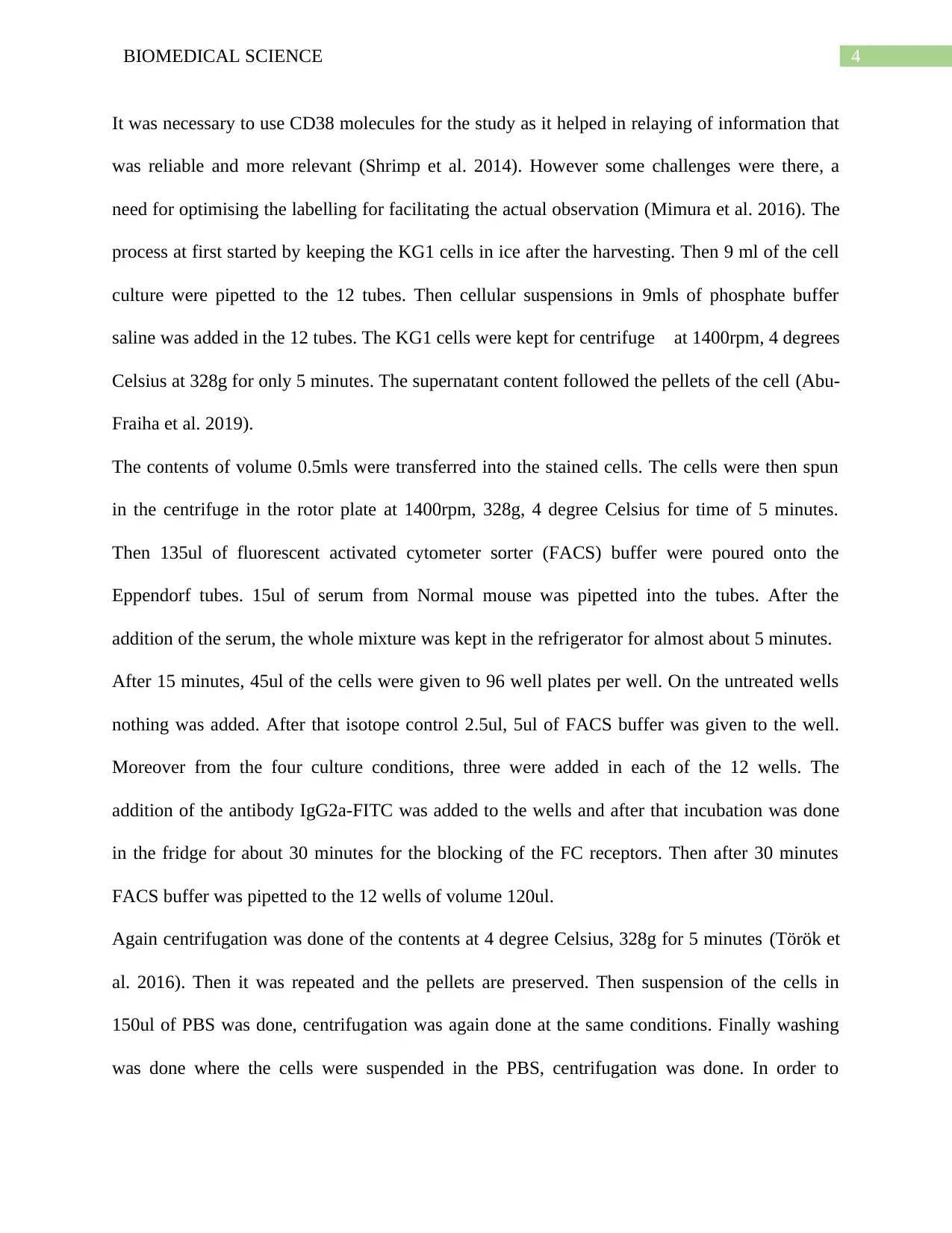
4BIOMEDICAL SCIENCE
It was necessary to use CD38 molecules for the study as it helped in relaying of information that
was reliable and more relevant (Shrimp et al. 2014). However some challenges were there, a
need for optimising the labelling for facilitating the actual observation (Mimura et al. 2016). The
process at first started by keeping the KG1 cells in ice after the harvesting. Then 9 ml of the cell
culture were pipetted to the 12 tubes. Then cellular suspensions in 9mls of phosphate buffer
saline was added in the 12 tubes. The KG1 cells were kept for centrifuge at 1400rpm, 4 degrees
Celsius at 328g for only 5 minutes. The supernatant content followed the pellets of the cell (Abu-
Fraiha et al. 2019).
The contents of volume 0.5mls were transferred into the stained cells. The cells were then spun
in the centrifuge in the rotor plate at 1400rpm, 328g, 4 degree Celsius for time of 5 minutes.
Then 135ul of fluorescent activated cytometer sorter (FACS) buffer were poured onto the
Eppendorf tubes. 15ul of serum from Normal mouse was pipetted into the tubes. After the
addition of the serum, the whole mixture was kept in the refrigerator for almost about 5 minutes.
After 15 minutes, 45ul of the cells were given to 96 well plates per well. On the untreated wells
nothing was added. After that isotope control 2.5ul, 5ul of FACS buffer was given to the well.
Moreover from the four culture conditions, three were added in each of the 12 wells. The
addition of the antibody IgG2a-FITC was added to the wells and after that incubation was done
in the fridge for about 30 minutes for the blocking of the FC receptors. Then after 30 minutes
FACS buffer was pipetted to the 12 wells of volume 120ul.
Again centrifugation was done of the contents at 4 degree Celsius, 328g for 5 minutes (Török et
al. 2016). Then it was repeated and the pellets are preserved. Then suspension of the cells in
150ul of PBS was done, centrifugation was again done at the same conditions. Finally washing
was done where the cells were suspended in the PBS, centrifugation was done. In order to
It was necessary to use CD38 molecules for the study as it helped in relaying of information that
was reliable and more relevant (Shrimp et al. 2014). However some challenges were there, a
need for optimising the labelling for facilitating the actual observation (Mimura et al. 2016). The
process at first started by keeping the KG1 cells in ice after the harvesting. Then 9 ml of the cell
culture were pipetted to the 12 tubes. Then cellular suspensions in 9mls of phosphate buffer
saline was added in the 12 tubes. The KG1 cells were kept for centrifuge at 1400rpm, 4 degrees
Celsius at 328g for only 5 minutes. The supernatant content followed the pellets of the cell (Abu-
Fraiha et al. 2019).
The contents of volume 0.5mls were transferred into the stained cells. The cells were then spun
in the centrifuge in the rotor plate at 1400rpm, 328g, 4 degree Celsius for time of 5 minutes.
Then 135ul of fluorescent activated cytometer sorter (FACS) buffer were poured onto the
Eppendorf tubes. 15ul of serum from Normal mouse was pipetted into the tubes. After the
addition of the serum, the whole mixture was kept in the refrigerator for almost about 5 minutes.
After 15 minutes, 45ul of the cells were given to 96 well plates per well. On the untreated wells
nothing was added. After that isotope control 2.5ul, 5ul of FACS buffer was given to the well.
Moreover from the four culture conditions, three were added in each of the 12 wells. The
addition of the antibody IgG2a-FITC was added to the wells and after that incubation was done
in the fridge for about 30 minutes for the blocking of the FC receptors. Then after 30 minutes
FACS buffer was pipetted to the 12 wells of volume 120ul.
Again centrifugation was done of the contents at 4 degree Celsius, 328g for 5 minutes (Török et
al. 2016). Then it was repeated and the pellets are preserved. Then suspension of the cells in
150ul of PBS was done, centrifugation was again done at the same conditions. Finally washing
was done where the cells were suspended in the PBS, centrifugation was done. In order to
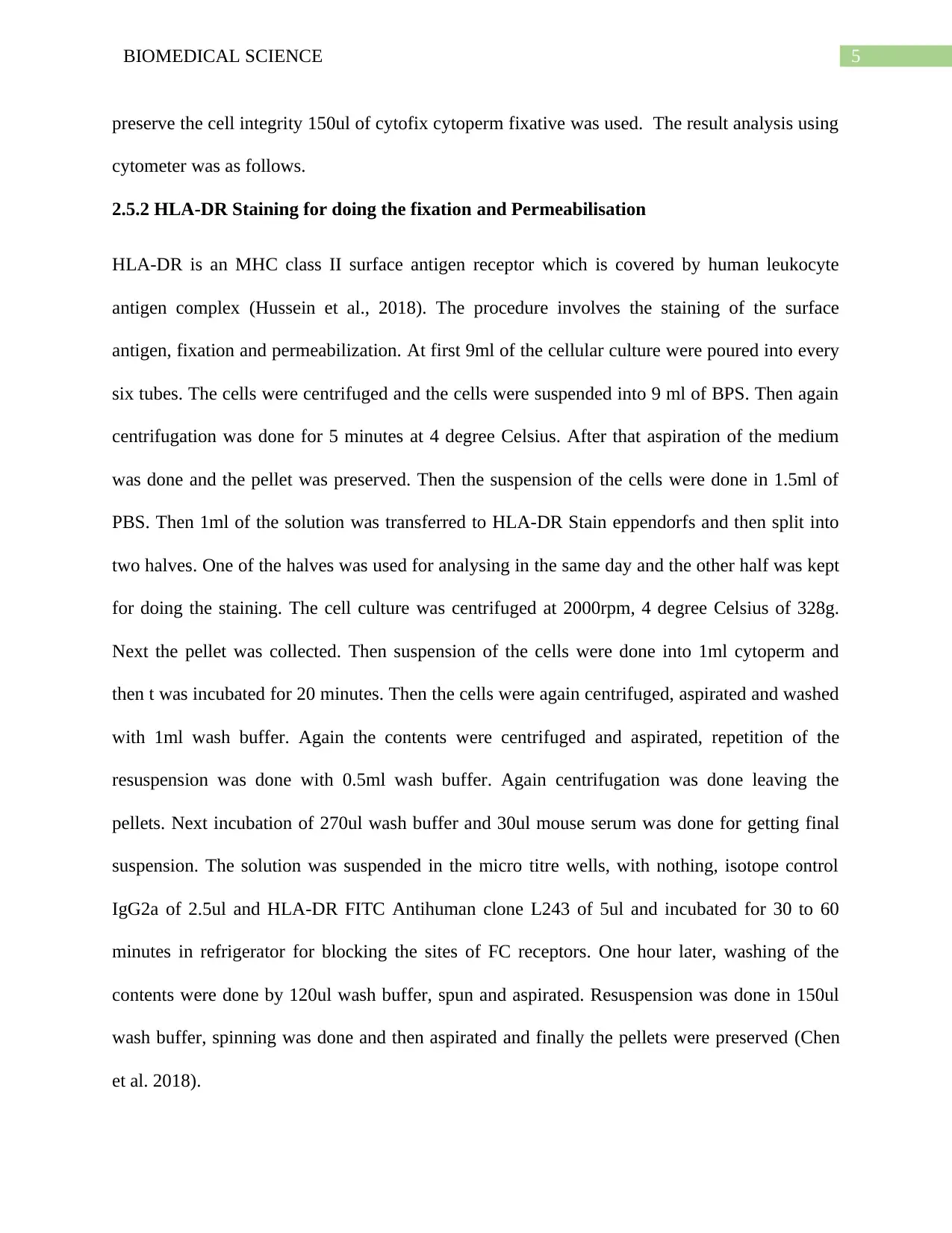
5BIOMEDICAL SCIENCE
preserve the cell integrity 150ul of cytofix cytoperm fixative was used. The result analysis using
cytometer was as follows.
2.5.2 HLA-DR Staining for doing the fixation and Permeabilisation
HLA-DR is an MHC class II surface antigen receptor which is covered by human leukocyte
antigen complex (Hussein et al., 2018). The procedure involves the staining of the surface
antigen, fixation and permeabilization. At first 9ml of the cellular culture were poured into every
six tubes. The cells were centrifuged and the cells were suspended into 9 ml of BPS. Then again
centrifugation was done for 5 minutes at 4 degree Celsius. After that aspiration of the medium
was done and the pellet was preserved. Then the suspension of the cells were done in 1.5ml of
PBS. Then 1ml of the solution was transferred to HLA-DR Stain eppendorfs and then split into
two halves. One of the halves was used for analysing in the same day and the other half was kept
for doing the staining. The cell culture was centrifuged at 2000rpm, 4 degree Celsius of 328g.
Next the pellet was collected. Then suspension of the cells were done into 1ml cytoperm and
then t was incubated for 20 minutes. Then the cells were again centrifuged, aspirated and washed
with 1ml wash buffer. Again the contents were centrifuged and aspirated, repetition of the
resuspension was done with 0.5ml wash buffer. Again centrifugation was done leaving the
pellets. Next incubation of 270ul wash buffer and 30ul mouse serum was done for getting final
suspension. The solution was suspended in the micro titre wells, with nothing, isotope control
IgG2a of 2.5ul and HLA-DR FITC Antihuman clone L243 of 5ul and incubated for 30 to 60
minutes in refrigerator for blocking the sites of FC receptors. One hour later, washing of the
contents were done by 120ul wash buffer, spun and aspirated. Resuspension was done in 150ul
wash buffer, spinning was done and then aspirated and finally the pellets were preserved (Chen
et al. 2018).
preserve the cell integrity 150ul of cytofix cytoperm fixative was used. The result analysis using
cytometer was as follows.
2.5.2 HLA-DR Staining for doing the fixation and Permeabilisation
HLA-DR is an MHC class II surface antigen receptor which is covered by human leukocyte
antigen complex (Hussein et al., 2018). The procedure involves the staining of the surface
antigen, fixation and permeabilization. At first 9ml of the cellular culture were poured into every
six tubes. The cells were centrifuged and the cells were suspended into 9 ml of BPS. Then again
centrifugation was done for 5 minutes at 4 degree Celsius. After that aspiration of the medium
was done and the pellet was preserved. Then the suspension of the cells were done in 1.5ml of
PBS. Then 1ml of the solution was transferred to HLA-DR Stain eppendorfs and then split into
two halves. One of the halves was used for analysing in the same day and the other half was kept
for doing the staining. The cell culture was centrifuged at 2000rpm, 4 degree Celsius of 328g.
Next the pellet was collected. Then suspension of the cells were done into 1ml cytoperm and
then t was incubated for 20 minutes. Then the cells were again centrifuged, aspirated and washed
with 1ml wash buffer. Again the contents were centrifuged and aspirated, repetition of the
resuspension was done with 0.5ml wash buffer. Again centrifugation was done leaving the
pellets. Next incubation of 270ul wash buffer and 30ul mouse serum was done for getting final
suspension. The solution was suspended in the micro titre wells, with nothing, isotope control
IgG2a of 2.5ul and HLA-DR FITC Antihuman clone L243 of 5ul and incubated for 30 to 60
minutes in refrigerator for blocking the sites of FC receptors. One hour later, washing of the
contents were done by 120ul wash buffer, spun and aspirated. Resuspension was done in 150ul
wash buffer, spinning was done and then aspirated and finally the pellets were preserved (Chen
et al. 2018).
⊘ This is a preview!⊘
Do you want full access?
Subscribe today to unlock all pages.

Trusted by 1+ million students worldwide

6BIOMEDICAL SCIENCE
1 out of 7
Your All-in-One AI-Powered Toolkit for Academic Success.
+13062052269
info@desklib.com
Available 24*7 on WhatsApp / Email
![[object Object]](/_next/static/media/star-bottom.7253800d.svg)
Unlock your academic potential
Copyright © 2020–2025 A2Z Services. All Rights Reserved. Developed and managed by ZUCOL.